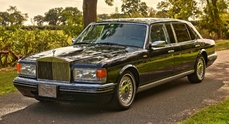Vauxhall 14-6 type Tourer by Jackson Jones & Colins. 1920
General description :
1920 Vauxhall D type tourer by Jackson Jones & Colins of Sydney
Chassis number: D3392
Registration number: IB993
Supplied new to Australia, this car was bodied by Jackson Jones & Colins of Sydney as an open tourer & retains its original coachwork to this day. The car was bought back to the UK in the 1990's & extensively restored in Wales. Later on it went through the hands of noted Irish collector Jim Boland prior to being purchased by the current owner.
The robust 4 litre engine gives this car plenty of go & makes for a big powerful vintage tourer. The car sports paintwork in good order in a fetching shade of turquoise along with black wings & a polished aluminium bonnet. To the inside is Black Buttoned leather with aluminium floodboards to the front & black carpet to the rear.
The aluminium dash has a full quotient of period instrumentation with a central C.A.V. (Charles A Vanderveld) switchbox. Similarly the lamps are also C.A.V. model E units. A very patinated shell fuel can is mounted to the running board as are dual sidemount spares. Wheels & Tyres are of the thin beaded edge variety. A full length hood easily erects for inclement driving conditions. The car comes to us with a good assortment of literature, bills & a UK v5 document.
This is a car that starts easily, cruises well in modern traffic & has an unstoppable "Go anywhere" feel to it. These early Vauxhalls were quality items many of which went to the colonies due to their ability to effortlessly cover high mileages in trying conditions.
http://www.vintagerollsroycecars.com/sales/1295/1920-vauxhall-d-type-tourer-by-jackson-jones-colins/
1920 Vauxhall 14-6 type Tourer by Jackson Jones & Colins. is listed sold on ClassicDigest in Grays by Vintage Prestige for £68000.
Car Facts
Car type : Car Make : Vauxhall Model : 14-6 Model Version : type Tourer by Jackson Jones & Colins. Engine size : 0.0 Model Year : 1920 Sub type : Van Location : Essex
Sold
Seller Information
Sold
Other cars listed for sale by this dealer
About Vauxhall
The history of Vauxhall Motors, a British automobile manufacturer, is a rich tapestry spanning more than a century, involving innovation, collaborations, and transitions.Early Years: Vauxhall was established in 1857 in Vauxhall, London, initially producing pumps and marine engines. In 1903, they ventured into automobile manufacturing, creating their first car, the Vauxhall 6HP. The brand gained a reputation for producing reliable vehicles.
Acquisition by General Motors (GM): In 1925, Vauxhall was acquired by General Motors (GM), which influenced its trajectory for several decades. This partnership brought technological advancements and expanded Vauxhall's market.
Genuine Vauxhall Models: In the earlier years of Vauxhall's history, especially before the collaboration with Opel, Vauxhall produced cars that were uniquely developed by the company. These vehicles, such as the Vauxhall Victor, Viva, and Cresta, were designed and engineered by Vauxhall independently of Opel.
Badge-Engineered Opels: As Vauxhall came under the ownership of General Motors (GM) in the mid-20th century, it became part of a network of GM-owned brands that included Opel in Germany. This led to the practice of badge engineering, where certain Opel models were rebranded and sold as Vauxhalls in the UK and vice versa.
For instance, models like the Vauxhall Carlton and Cavalier had their counterparts in the Opel range, such as the Opel Omega and Ascona. These cars were essentially the same vehicles with minor cosmetic differences and were marketed under different badges for specific markets.
This strategy allowed GM to streamline production and development costs by sharing platforms and technologies across markets, thereby creating cars that were economically feasible for different regions while retaining a semblance of distinct branding.
Perceived Differences: While many of these badge-engineered models shared much of their engineering, components, and technology, there were perceptions among some consumers and critics that Opel-badged cars might have been slightly more refined or better equipped compared to their Vauxhall counterparts. However, this perception wasn't universal and might not have been true for all models.






